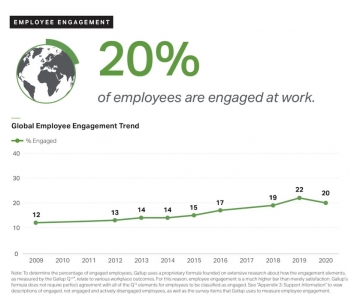Intrapersonal skills as the most beneficial investment in employee engagement
Corporate wellness training focusing on improving mental sharpness, mental fitness and intrapersonal skills uplifts employee engagement. Such HR training is crucial in all those workplaces where bright minds are the key input to securing different products and services.
Without excellent intrapersonal skills, genuine caring and interest in what you do, the actual work engagement is bound to fade. Creativity will drop. What is left is a numb routine. When your mind becomes stressed and ill, it can't focus as easily as when you felt fit and well.
Engaged people believe in what they are doing
Recently, Milena Iacovelli, who worked 10 years in the HR Department, posted on LinkedIn "What makes the difference is the quality of people you work with. When you deal with not engaged employees, the challenges are really hard to face.
Yes, they may do the work, but it may be not on time and you cannot really count on them for extra effort. What they want is just to do what they need to do, and that's it. And you can feel that they don't trust what's going on. They are quite skeptical about situations.
The opposite is working with engaged people. They believe they can do things and they believe in what they are doing. The vibes are completely different. Working with them is fun, is motivating, is something else. Working with them is rewarding. The team spirit is there and you can feel it."
Team spirit and employee engagement become difficult when we face long and difficult challenges. All workplaces do that sooner or later.
The employee engagement questions to ask here are:
- Is your brain/mind trained to deal with stress and different challenges?
- Are your people able to stay engaged and productive when the ride is rough or do you see a productivity drop instead?
- Do your people have excellent self-leadership skills?
- Do you see the initiative and focus or procrastination and delays?
- How much do you invest in your employee's (mental) wellbeing, and if you don't, are you aware of your annual business loss due to this?
WHAT IS THE DEFINITION OF EMPLOYEE ENGAGEMENT AND HOW IS THE GLOBAL SITUATION?
Gallup defines employee engagement as "the involvement and enthusiasm of employees in their work and workplace". Without employee engagement, team engagement becomes impossible and business outcomes are poor. So, it is more than feeling rewarded.
Getting employee engagement levels up makes a lot of business sense. And there is plenty of room for improvement. Let's observe the data from 2021.
Global statistics by Gallup point out that the employee engagement situation around the world is far from satisfactory, see the graph below.
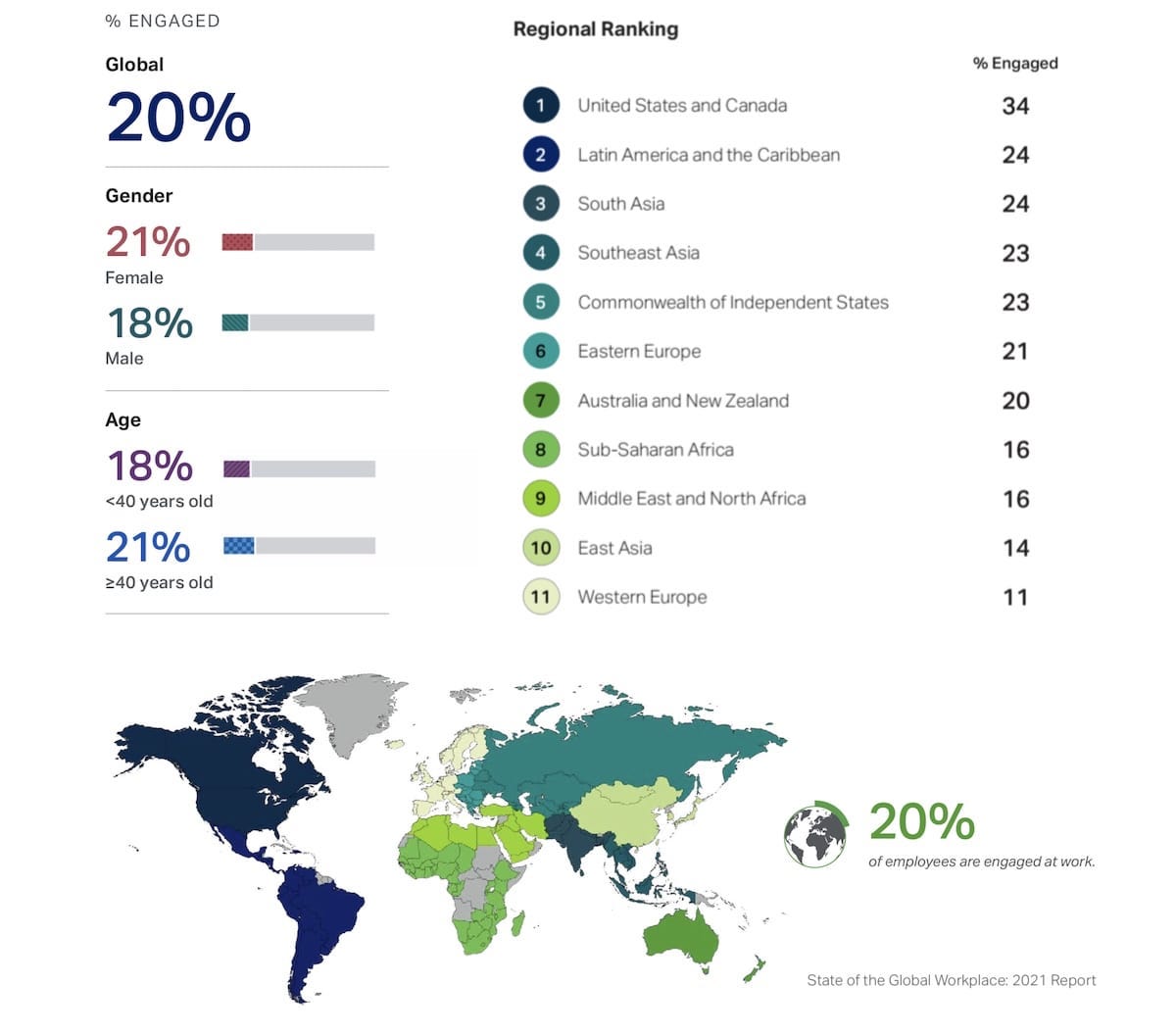
Intrapersonal skills training is an investment in employee engagement
Investing in employee engagement is, first and foremost, an investment in your people.
Such an approach works well when it is proactive.
You benefit the most from educating your people to take initiative while they are well. Educating them to unlearn their inner reactivity and learning adequate aware response is the key to success when the ride gets rough.
People who are valued, and have excellent intrapersonal skills work well under any circumstances. People without intrapersonal skills fail when there are many stressors and difficult challenges.
Intrapersonal skills as the foundation of workplace wellness
When the workplace culture is based on shared intrapersonal skills, it lays a foundation for individual initiative and responsibility.
Being engaged in any task is based on initiative. Staying engaged is about responsibility and the ability to focus.
When stress takes over and people lose their mental sharpness and mental wellness they become distracted and start avoiding their actual tasks. When you look at annual data from other studies, you can notice that approximately 70-80% of employees, managers, business owners and HRs are stressed.
Now, look again at annual employee engagement levels. Observe the graphs above and below and you will notice only 20 to 30% of employees are engaged. Coincidence?
It means a simple thing when you are stressed, your engagement level fades.
The more stressed and burned out you are and the more mental health issues you face, the less willpower you have left to care. You do what is told or demanded. It isn't an absolute thing, as some mental health issues allow you to care narrowly, but the fact is all mental health issues complicate the work on a broad scale.
You take no initiative as you lack the inner power for this as worry, stress and personal problems darken your mind.
To build a better and more successful workplace intrapersonal education is a must. Otherwise, the mentality is like in kindergarten, you need to tell what to do.
What is your (team's) potential here?
Employee engagement potential
Your realistic employee engagement target is above 70%, as illustrated by the following graph by Gallup.
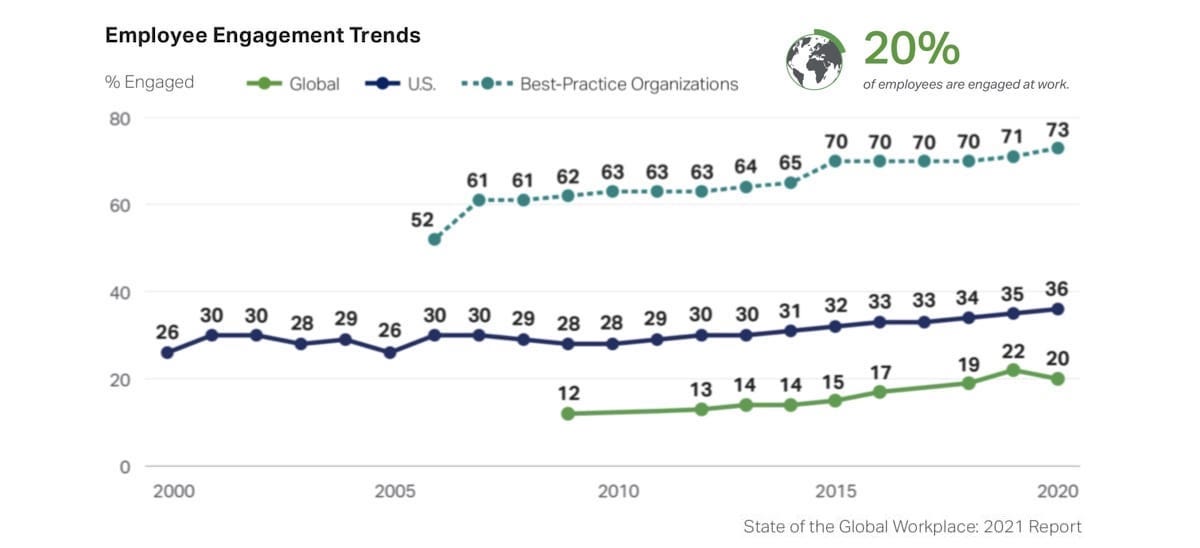
The graph above points out that best practice makes a huge difference as it brings improved employee engagement levels. Presumably, you'll discover, in such workplaces, lower stress levels, better self-leadership and more initiative as people love what they do for work.
Where should you start?
First, stress reduction skills are an absolute must.
Less stress means better focus, improved health and easily accessible creativity. The stress levels were high across all age groups already pre-pandemic era, as you can see on the graph below.

Second, when people have stress reduction skills focus on improving mental sharpness and strength by allowing people to learn practical intrapersonal skills.
Training your mind/brain is scientifically based on the fact that the human brain is neuroplastic. What does neuroplasticity allow?
Change and initiative. To be more precise, neuroplasticity allows you to mold your brain patterns by learning how to lead your own intrapersonal processes more consciously.
Becoming more aware of your own awareness and various intrapersonal processes will allow you to alter the existing unhealthy mental and emotional patterns that your brain has subconsciously learned. It takes you off from 'autopilot', thus enabling you to discover self-leadership basics.
When your intrapersonal base becomes grounded on a solid foundation, you can work efficiently and wisely. Also, you can become engaged with any task at hand as long as needed to solve it. You start to love challenges instead of fearing problems. You become unfrozen.
We can illustrate the benefits of intrapersonal skills with the following graph. Study it as you may discover the connection between the fit inner domain and the desired work environment on this graph is easily visible.
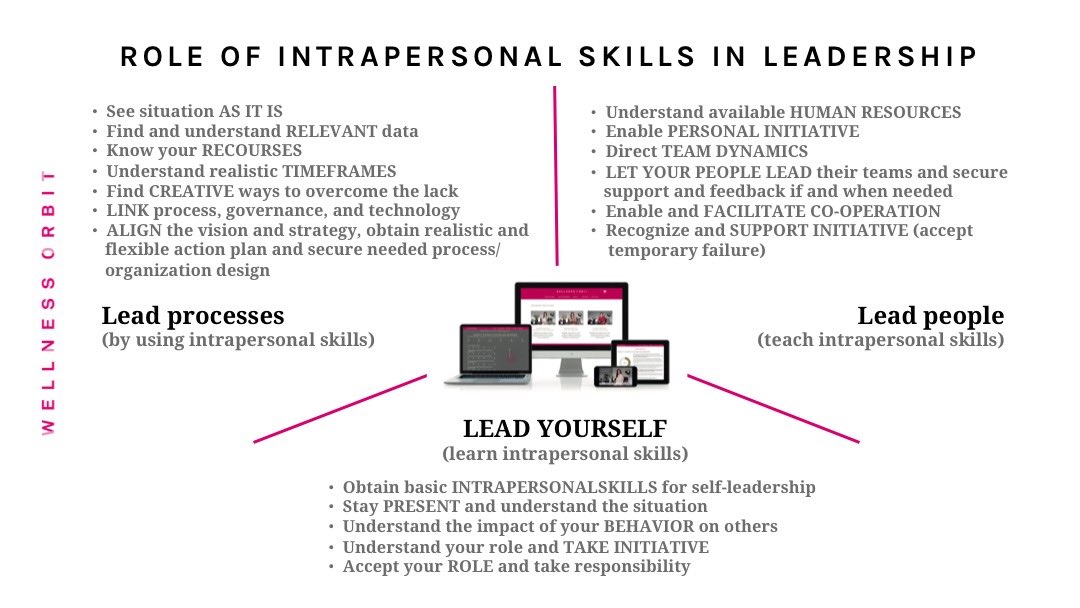
Leading yourself first is the basis here. As the graph above shows, the rest is founded upon this self-aware base.
In this sense, a fit mind is more than a blessing, it is your business asset that can empower creativity and initiative.
A fit mind is, in addition, the foundation of health.
When you know how to keep your stress at bay and lead yourself, you can also nip most if not all, (mental) health problems in the bud.
LACK OF WELLBEING LEADS TO A LACK OF EMPLOYEE ENGAGEMENT
In their post 'Showing That You Care About Employee Wellbeing' Gallup pointed out, "Today, just 24% of workers strongly agree that their organization cares about their wellbeing – which should be of great concern to leaders given that these employees are 69% less likely than all other workers to search for a new job, 71% less likely to report experiencing burnout and five times more likely to serve as an advocate for their organization." This sums it up pretty well.
Are you focusing on keeping your brightest minds in your team by providing easy-to-use mental sharpness and mental fitness trainings for your whole team?
Conceivably you should, as the latest Deloitte UK report ‘Mental health and employers. The case for investment – pandemic and beyond' pointed out, the annual unacknowledged mental health cost per employee varies between £1035 ($1345 or 1150€) and £3,710 ($4820 or 4,120€) while the ROI of such investments can be tenfold. We will share this information in our next blog post, so stay tuned!
For now, we point out a graph that is about the stress people felt the previous workday. It is not comparable to annual employee engagement numbers (there you need to compare average annual stress levels as we did above), but it points out those stress reduction skills are truly lacking among people. Why does this matter?
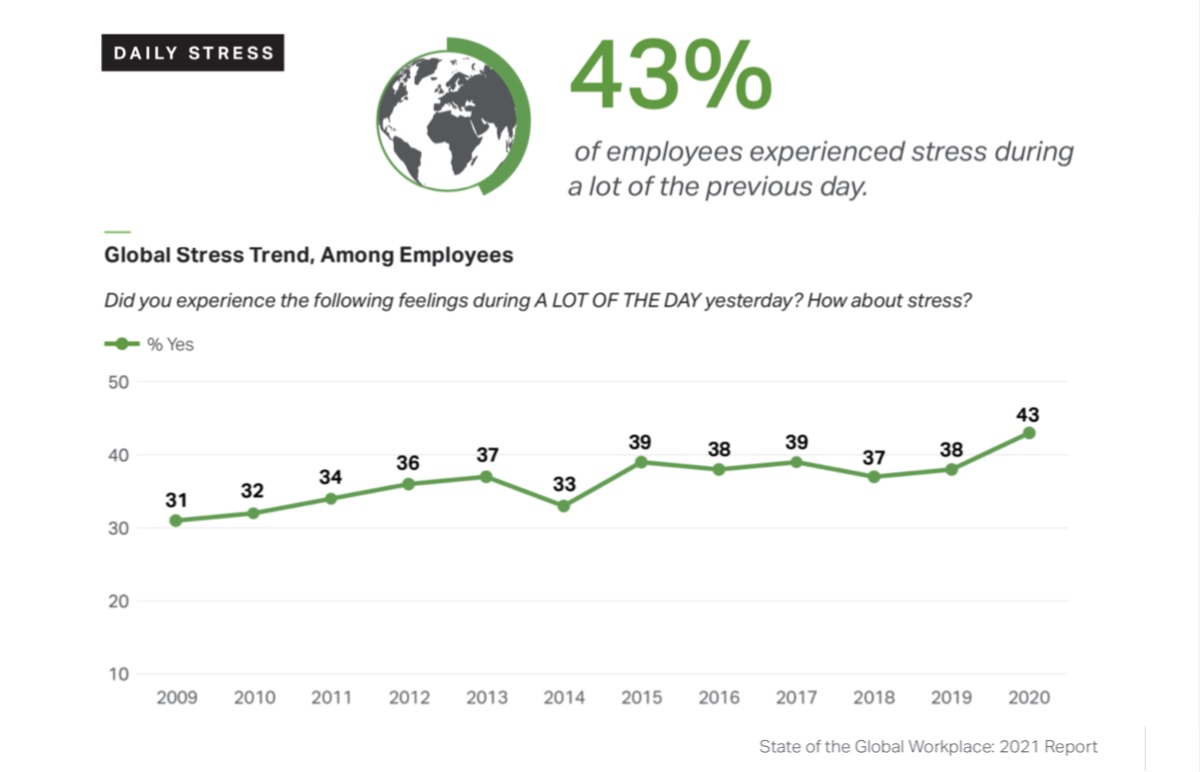
Stress is the leading cause of burnout, and it drives up anxiety and leads to depression and even more serious mental health issues. By now there is a better understanding of what’s actually happening in your body – it all starts with stress as the message has been clear for some years now.
Employee engagement, stress reduction and mental wellness topics are not just "an HR thing" when problems appear. Those topics should be owned by all leaders and understood by front-line employees. It is pure business sense to train intrapersonal skills and invest in mental wellness.
Truly exploring employee engagement comes down to leaders and teams training their minds to discover their full inner potential. This is what allows the whole team, as one unit, to transform your current difficult business to a sustainable and thriving level.
CONCLUSIONS
The lack of engagement is an obvious outcome when you see stress, worry, gossip and toxic work relations. All inner processes consume our time and reduce our external efforts. We can't perform at our peak levels when we feel stressed or anxious. We can't perform well in a non-supporting environment and among toxic workplace cultures. Or we can, but we end up burning out.
When we have leaders and HRs with fit minds who are interested in keeping their employees mentally sharp and well, people can thrive and your business can thrive. As Milena Iacovelli stated engaged employees "believe they can do things and they believe in what they are doing."
Working with an engaged and mentally fit team is fun and motivating. The task and challenges become the motivation as people seek solutions instead of freezing up. Working in an engaged team is rewarding as you feel the team spirit and support.
No one is capable of performing their peak 100% of the time, but as we see from Gallup's best example, driving up employee engagement from the current 20-30% to above 70% is a very realistic target. And here investment in intrapersonal skills offers up to tenfold ROI.
The grass is green where you water it. People are well where there is a healthy work environment and opportunity to train their minds and their physical bodies. A lovely office and physical activities alone are not enough. That is why we need a workplace mental wellness revolution!

This employee engagement blog post is authored by Kaur Lass. Updated 21.03..2024


